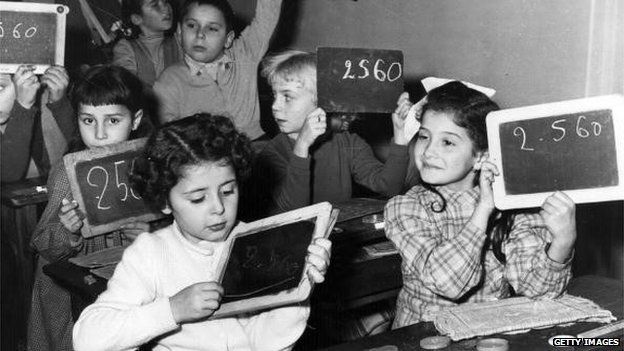Social media transforms the textbook lesson
- Published

Forget the blackboard and the chalk. In fact, forget the whiteboard and the markers.
The exercise books, the textbooks and the stationery can also be packed away. There is no need for any of them in the classroom of the future.
A room full of students with a tablet each and a teacher with an enthusiasm for social media is all that is required to engage developing minds.
At least in one school in Norway this isn't a vision of the future. This is now.
Ann Michaelsen, a teacher at Sandvika High School just outside Oslo, has been invited to Bett - the education world's biggest tech fair, held in London - to share her ideas with other technologically minded teachers.
"Social media is first and foremost a place to get connected - we do it every single day outside school or work, sometimes in work," she says.
"Most people would encourage connections - school seems to be the last place where that is allowed. It's almost restricted."
'Digitally rich'
Every student in Ms Michaelsen's English class is taught how to set up their own blog. This becomes where they display their work, which others can comment on, and the teacher can mark online.
"I don't use textbooks at all because I think that limits how you teach. I post something on the front of my blog and tell my students: 'This is what we're going to do today', " she says.
The aim of this method, she adds, is to create a "digitally rich" environment where pupils drive learning and classrooms are constantly online, allowing students to be creative by making their own discoveries rather than being led by a teacher.
"You can't grade being inventive," she adds.
The class also uses Quadblogging - software that allows four schools to join up online and interact and comment on each other's blogs.
"It's been really exciting because we can read, comment and exchange information with students in other countries," says Haakon Bakker, a 17-year-old student at Sandvika.
Innovative thoughts
Updates and instructions are given via a group Facebook page. Being a member of a group means Ms Michaelsen doesn't need to address the tricky issue of friend requests from students as people can interact on the page without needing to be Facebook friends first.
Twitter is used to gain inspiration from classes and teachers around the world.
"If you're an English teacher and you're not using Twitter then you're missing out," she explains.
"Teachers are sharing interesting, innovative thoughts. There are people from the US, South Africa and New Zealand on my feed, I can ask people around the world for help."
The class also makes use of Skype and has link-ups with schools in Lesotho, China and North America.
"We use it to ask them about cultural differences and how different their lives are," explains Haakon.
Sandvika operates a one-to-one policy where every student is provided with a tablet and wi-fi operates throughout the school.
For Jim Watson, a UK teacher attending Bett from Burntwood School in Wandsworth, the availability of resources like those at Sandvika is a long way off.
The school already uses a system called Word Wall, which allows his students to use a handheld wireless keyboard to take part in an activity on a large interactive screen at the front of the classroom.
A new version of the software that uses tablets is being rolled out but currently Burntwood does not have tablets. It is looking at developing a bring-your-own-device to school programme as a work-around.
For UK classrooms to be on a par with those at Sandvika, he thinks the attitude of teachers towards social media needs to be addressed.
"Everyone is scared," he says. "For 15 years teachers have been saying 'put your phone away' in class - now it's 'get them out'."
Mr Watson trialled his own social media method by taking part in an "exam clinic" on Twitter: a last minute question-and-answer session with his students the night before one of their A-Level exams.
He says that the response was positive and he would like to do more.
Age gap
Janet Crompton teaches much younger children at Leckhampton School in Cheltenham and acknowledges that even at primary school-level technological advancements can be daunting for teachers.
"Individual teachers don't need to be totally up to date but they do need to be open and willing to new ideas," she adds.
It is a sentiment that Ann Michaelsen agrees with, particularly in regard to the increasing presence of social media in her students' lives.
"If teachers don't know how to do this sort of thing then nothing will change. If students don't know how to do this then they'll be as conservative as the teachers about it," she says.
Student Hanne Wiger is keen to let others know what this way of learning means to her.
"I think it makes life easier, if you're not in class then you can just go online. You're not missing out," she says.
Could Haakon and Hanne imagine a school life without social media now?
They both laugh.
"No, just simply no."
- Published1 November 2013
- Published22 January 2014
- Published21 October 2013